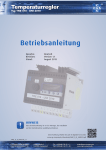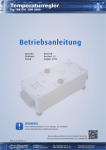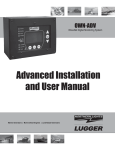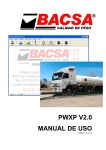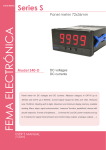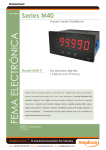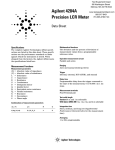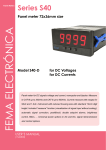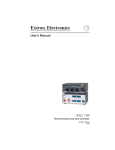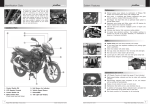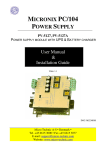Download B 70.2040 Operating Instructions
Transcript
Compact microprocessor controllers B 70.2040 Operating Instructions 01.04/00357918 ) Please read these Operating Instructions carefully before starting up the instrument. Keep these operating instructions in a place which is at all times accessible to all users. Please assist us to improve these operating instructions where necessary. Your suggestions will be most welcome. Phone in Germany (02242) 8703-0 from abroad (+49) 2242 8703-0 Fax in Germany (02242) 8703-20 abroad (+49) 2242 8703-20 ) All necessary settings are described in these operating instructions. However, if any difficulties should still arise during start-up, you are asked not to carry out any unauthorized manipulations on the unit. You could endanger you rights under the instrument warranty! Please contact the nearest subsidiary or the main factory in such a case. E When returning chassis, assemblies or components, the regulations of EN 100 015 “Protection of electrostatically sensitive components” must be observed. Use only the appropriate ESD packaging for transport. Please note that we cannot accept any liability for damage caused by ESD (electrostatic discharge). Contents 1 2 3 4 6 7 8 Contents 5 Identifying the instrument version . . . . . . . . . . . . . . . . . . . . . . . . . . . . . . . . . . . . . . . . . . . 4 Installation . . . . . . . . . . . . . . . . . . . . . . . . . . . . . . . . . . . . . . . . . . . . . . . . . . . . . . . . . . . . . . . 6 Electrical connection . . . . . . . . . . . . . . . . . . . . . . . . . . . . . . . . . . . . . . . . . . . . . . . . . . . . . . 7 Operation . . . . . . . . . . . . . . . . . . . . . . . . . . . . . . . . . . . . . . . . . . . . . . . . . . . . . . . . . . . . . . 12 4.1 Displays and keys . . . . . . . . . . . . . . . . . . . . . . . . . . . . . . . . . . . . . . . . . . . . . . . . . . . . 12 4.2 Principle of operation . . . . . . . . . . . . . . . . . . . . . . . . . . . . . . . . . . . . . . . . . . . . . . . . . . 13 4.3 Operation of the timer function . . . . . . . . . . . . . . . . . . . . . . . . . . . . . . . . . . . . . . . . . . 15 Functions . . . . . . . . . . . . . . . . . . . . . . . . . . . . . . . . . . . . . . . . . . . . . . . . . . . . . . . . . . . . . . . 16 5.1 Process value input . . . . . . . . . . . . . . . . . . . . . . . . . . . . . . . . . . . . . . . . . . . . . . . . . . . 17 5.2 Logic input . . . . . . . . . . . . . . . . . . . . . . . . . . . . . . . . . . . . . . . . . . . . . . . . . . . . . . . . . . 18 5.3 Controller . . . . . . . . . . . . . . . . . . . . . . . . . . . . . . . . . . . . . . . . . . . . . . . . . . . . . . . . . . . 19 5.4 Limit comparator (alarm contact) . . . . . . . . . . . . . . . . . . . . . . . . . . . . . . . . . . . . . . . . . 21 5.5 Ramp function . . . . . . . . . . . . . . . . . . . . . . . . . . . . . . . . . . . . . . . . . . . . . . . . . . . . . . . 22 5.6 Self-optimization . . . . . . . . . . . . . . . . . . . . . . . . . . . . . . . . . . . . . . . . . . . . . . . . . . . . . 23 5.7 Level inhibit via code . . . . . . . . . . . . . . . . . . . . . . . . . . . . . . . . . . . . . . . . . . . . . . . . . . 24 5.8 Timer function (extra code) . . . . . . . . . . . . . . . . . . . . . . . . . . . . . . . . . . . . . . . . . . . . . 25 Configuration and parameter tables . . . . . . . . . . . . . . . . . . . . . . . . . . . . . . . . . . . . . . . . 31 Alarm messages . . . . . . . . . . . . . . . . . . . . . . . . . . . . . . . . . . . . . . . . . . . . . . . . . . . . . . . . . 37 Technical data . . . . . . . . . . . . . . . . . . . . . . . . . . . . . . . . . . . . . . . . . . . . . . . . . . . . . . . . . . 39 1 Identifying the instrument version (2) (3) (4) (5) (6) 7020 . . / . . – . . . – . . . – . . / . . . ,... (1) Basic type (bezel in mm) 40 = 48 x 24, 41 = 48 x 48, 42 = 48 x 96 (portrait), 43 = 96 x 48 (landscape), 44 = 96 x 96 (2) Basic type extension 88 = controller type configurable1 99 = controller type configured to customer specification2 (3) Inputs 888 = inputs configurable1 999 = inputs configured to customer specification2 (4) Outputs 000 = Standard Type 702040/41 Type 702042/43/44 Output 1 relay (n.o. make) relay (n.o. make) Output 2 logic 0/5V, optionally configurable als logic input logic 0/5V Output 3 (not available) relay (n.o. make) Options Type 702040/41 Type 702042/43/44 logic 0/12V, optionally configurable als logic input logic 0/12V 113 = Output 2 (outputs 1+3 as for Standard) 101 = Output 2 (output 1 as for Standard) 1 Identifying the instrument version (1) relay (n.o. make) not possible (logic input is always available) 1. single-setpoint controller with limit comparator, see factory settings under configuration and parameter level 2. see customer’s ordering text or settings under configuration and parameter level 4 (5) Supply Delivery package 061 = UL approval (Underwriter Laboratories) 210 = Timer function Type 702040/41 Type 702042/43/44 1 mounting frame 2 mounting brackets 1 seal, 1 Operating instructions 70.2040 1 Identifying the instrument version (6) Extra code 16 = 10—18V DC 22 = 20—53V AC/DC, 48—63Hz 23 = 110—240V -15/+10% AC 48— 63Hz 5 2 Installation Type (bezel) 3. Push on mounting brackets 4. Tighten screws 1. Push on seal 2. Insert instrument Panel cut-out (WxH) in mm Edge-to-edge-mounting (minimum spacings of panel cut-outs) horizontal 702040 (48mm x 24mm) 702041 (48mm x 48mm) 702042 (48mm x 96mm) 702043 (96mm x 48mm) 702044 (96mm x 96mm) 45+0.6 x 22.2+0.3 45+0.6 x 45+0.6 45+0.6 x 92+0.8 92+0.8 x 45+0.6 92+0.8 x 92+0.8 2 Installation Installation 702042 as 702044. > 8mm > 8mm > 10mm > 10mm > 10mm vertical > 8mm > 8mm > 10mm > 10mm > 10mm 6 3 Electrical connection Installation notes - The electrical connection must only be carried out by qualified personnel. - If contact with live parts is possible when working on the instrument, it must be isolated on both poles from the supply. - A current limiting resistor interrupts the supply circuit in the event of a short-circuit. The load circuit must be fused for the maximum relay current in order to prevent welding of the output relay contacts in the event of an external short-circuit. - Electromagnetic compatibility conforms to the standards and regulations listed under Technical Data. 3 Electrical connection - The choice of cable, the installation, the fusing and the electrical connection must conform to the requirements of VDE 0100 “Regulations on the Installation of Power Circuits with nominal voltages below 1000V”, or the appropriate local regulations. - Run input, output and supply lines separately and not parallel to each other. 7 - Do not connect any additional loads to the supply terminals of the instrument. - The instrument is not suitable for installation in hazardous areas. - All input and output lines that are not connected to the supply network must be laid out as shielded and twisted cables (do not run them in the vicinity of power cables or components). The shielding must be grounded to the earth potential on the instrument side. 3 Electrical connection - Apart from faulty installation, there is a possibility of interference or damage to controlled processes due to incorrect settings on the controller (setpoint, data of parameter and configuration levels, internal adjustments). Safety devices independent of the controller, such as overpressure valves or temperature limiters/monitors, should always be provided and should be capable of adjustment only by specialist personnel. Please refer to the appropriate safety regulations in this connection. Since auto-tuning (selfoptimization) cannot be expected to handle all possible control loops, there is a theoretical possibility of unstable parameter settings. The resulting process value should therefore be monitored for its stability. 8 Type 702040/41 2 3 Output 1 Relay 5V(12V)/20mA + – 250V/3A 4 5 2 6 8 Supply see label 9 N L1 AC ⵒ 1 110—240V Thermocouple + ϑ ⵒ 20—53V Current 0/4—20mA + DC The electrical con= nection must only be carried out by qualified personnel. 10—18V – V ϑ + Pt100/1000 KTY11-6 (2-wire) – Pt100/1000 (3-wire) AC/DC floating contact – + Logic input 3 Electrical connection 1 Output 21 Logic output Mains supply – 1. Output or logic input (configurable) 2. resistive load Voltage 0/2—10V – + Process value input 9 Outputs Type 702040/41 with 2 relay outputs (option) Relay 250 V/3 A 2 2 3 4 5 7 1 8 9 N L1 AC ⵒ + AC/DC – – ϑ 20—53V The electrical connection must only be carried out by qualified personnel. DC = – V ϑ + Pt100/1000 KTY11-6 (2-wire) Current 0/4—20 mA ⵒ + Thermocouple Pt100/1000 (3-wire) 110—240V Logic input 3 Electrical connection 1 Supply see label 10—18V + – Mains supply Voltage 0/0.2—1 V + - Process value input 10 Type 702042/43/44 2 3 4 Output 1 Relay 5V(12V)/20mA + – 250V/3A 5 6 7 2 9 10 Output 3 Relay 2 250V/3A 12 13 Supply see label N L1 AC ⵒ Thermocouple + ⵒ ϑ 20—53V DC ϑ = + – The electrical connection must only be carried out by qualified personnel. – V Current 0/4—20mA + Pt100/1000 KTY11-6 (2-wire) AC/DC – Pt100/1000 (3-wire) floating contact – 110—240V + Logic input 3 Electrical connection 1 Output 2 Logic output 10—18V Mains supply 2. resistive load Voltage 0/2—10V – + Process value input 11 4 Operation 4.1 Displays and keys (1) Display 4 places, green Display alternates when setpoints, parameters and codes are entered and indicated. Character height Type 702040/41/42: 10mm Type 702043/44: 20mm Display range -1999 to +9999 digit Decimal places none, one, two Unit ° C/ °F (process value display) 4 Operation 7-segment display (2) Status indicators LED Example: Type 702041 two LEDs for the outputs 1 and 2, yellow (3) Keys q, i, d for operating and programming the instrument. Dynamic modification of settings and parameters. h Increase value with i h Decrease value with d Automatic value acceptance after 2 seconds. 12 4.2 Principle of operation A 4 Operation Normal display The display shows the process value. Operating level The setpoint SP is input here. On active setpoint switching via the logic input, SP 1 or SP 2 appears in the display. When the ramp function is active, the ramp setpoint SPr is displayed. With activated timer function, the timer value t i or the timer start value t i 0 is shown. The setpoint is altered dynamically using the i and d keys. The setting will be accepted automatically after approx. 2 sec. Parameter level The setpoints, the limit value of the limit comparator, the controller parameters and the ramp slope are programmed here. Configuration level The basic functions of the controller are set here. In order to make the settings, it is necessary to change to the configuration level via the parameter y:0 (parameter level). Timer level The current timer value (only when the timer has been started) and the timer start value are altered here. The parameters at this level are marked with an underscore in the display. Time-out If no operation occurs, the controller returns automatically to normal display after approx. 30 sec (exception: with timer functions starting via power ON, the timer value is displayed). If the timer value is displayed at the operating level, time-out is not active. 13 Normal display Process value 259 Operating level Ramp setpoint* (display only) > 2s Parameter level Pb:1 - setpoint 1+2 - limit value for limit comparator - controller parameters - ramp slope SPr Y.0 after last parameter q +d Configuration level Setpoint (with setpoint switching SP 1 or SP 2) SP - configuration codes - standard signal scaling - process value correction - switching differential of limit comparator > 2s ti Timer value* (operating only; different display i/i+d depending on timer condition (see table)) Time-out * only displayed if function is configured > 2s via y.0 ! C111 4 Operation Time-out (30s) or A after last parameter Timer level (timer stopped!) alter current timer value (only when timer has been started) ti set/alter timer start value ti0 Underscore to differentiate operating and timer level 14 4.3 Operation of the timer function The timer can be operated with the keys (start, stop, cancel, acknowledge) if the timer at operating level is indicated. Time-out is not active here. If the logic input is configured accordingly, then a key, such as the i key, can be used. In this case, the timer can also be operated even if the timer value does not appear in the display. Possible displayed parameters for timer function at operating level Display Display State/Action Timer has stopped h Continue with i h Cancel with i + d Timer has been started but the tolerance limit has not yet been reached h Cancel with i + d Timer running; t i is displayed h Stop with i Timer has run down h Acknowledge with any key (timer start value t i 0 is indicated) With time-delayed control (C120=3), acknowledge with i + d 4 Operation State/Action Timer not running h Start with i h Cancel with i + d When the timer has been started, the decimal point in the display for the timer value will blink! 15 5 Functions We recommend the following procedure: h Familiarize yourself with the controller functions h Enter the configuration code and parameters on the instrument Configuration Single-setpoint controller Double-setpoint controller Masking out the parameters for Double-setpoint controller Limit comp. for Type 702040/41 Logic input for Type 702040/411 Limit comparator no function Limit comparator activated Limit comparator Logic input for Type 702040/411 Resistance thermometer, thermocouple Ramp function off Standard signal scaling Ramp function Setpoint switching not activated Timer function: no function Type 702040/41 Setpoints at the parameter level Timer function Output 3 1. not for Type 702040/41 with 2 relay outputs (option) Parameter Pb:2, Cy 2, db, HyS.2 C114, HySt, AL C117 HySt, AL C117 SCL, SCH rASd, SPr SP 1, SP 2 ti , C121, C122, C123 C118 5 Functions h Enter the configuration codes and the parameter values in the tables provided for this purpose in Chapter 6. Write down the appropriate values ( ), or mark selection with a cross (X ). The parameters and the configuration codes are listed in the order of their appearance. Parameters which are not relevant are masked out (see table below). 16 5.1 Symbol dF Notes Transducer/probe (process value input) vpage 31 Unit of process value (°C/°F)/decimal places of display vpage 31 Start/end value of value range for standard signals vpage 35 Example: 0—20 mA→20—200°C: SCL = 20 / SCH = 200 Process value correction vpage 35 Using the process value correction, a measured value can be corrected by a programmable amount upwards or downwards (offset). Lead compensation can be implemented in software for 2-wire circuit through process value correction. 5 Functions C111 C112 SCL SCH OFFS Process value input Examples: Measured value Offset Displayed value 294.7 + 0.3 295.0 295.3 - 0.3 295.0 Filter time constant (damping) to adapt the digital input filter (0sec = filter off) vpage 36 if dF high: - high damping of interference signals - slow reaction of the process value display to changes in the process value - low cut-off frequency (2nd order low-pass filter) 17 5.2 Logic input Operation is possible from keys. No operation from keys. Level inhibit Access to the parameter and configuration levels is possible. Starting self-optimization is possible. No access to the parameter and configuration levels. Starting self-optimization is not possible. Ramp stop Ramp running Ramp stopped Setpoint switching Setpoint SP Setpoint SP 1 is active The appropriate symbols SP Timer control Symbol C117 2 is active 1 and SP 2 are displayed at the operating level. Acknowledge start/stop/continue/timer run-down (edge-triggered) 5 Functions Key inhibit Notes Function of the logic input vpage 33 On Type 702040/41, the parameter C117 is masked out if output 2 has been programmed as controller output (C113) or the limit comparator has been configured (C114) (double assignment; not on Type 702040/41 with 2 relay outputs (option)). 18 5.3 Controller Controller structure The controller structure is defined via the parameters Pb, dt and rt. Example: Setting for PI controller → Pb .1=120, dt=0sec, rt=350sec Symbol C113 C118 Pb:1 Pb:2 dt rt Cy 1 Cy 2 Derivative time vpage 36 Influences the D action of the controller. If dt=0, the controller has no D action. Reset time vpage 36 Influences the I action of the controller. If rt=0, the controller has no I action. Cycle time 1 (controller output 1) vpage 36 Cycle time 2 (controller output 2) The cycle time has to be selected so that the energy supply to the process is virtually continuous, while not subjecting the switching elements to excessive wear. 5 Functions C116 Notes Controller type and assignment of the controller outputs to the physical outputs 1+2 vpage 32 Outputs in fault condition vpage 33 The switching states of the outputs are defined here in the event of over/underrange, probe break/short circuit or display overflow. v Chapter 7 Assignment of the outputs vpage 33 Only for Type 702042/43/44; overwrites the assignment of C113 (controller type as C113) Proportional band 1 (controller output 1) vpage 36 Proportional band 2 (controller output 2) Influences the P action of the controller. If Pb=0, the controller structure is not effective. 19 Symbol db Notes Contact spacing vpage 36 for double-setpoint controller Differential 1 (controller output 1) vpage 36 Differential 2 (controller output 2) for controllers with Pb.1=0 or Pb.2=0 Y:0 Working point (basic load) vpage 36 Output if process value=setpoint Output limiting vpage 36 y:1 - maximum output y:2 - minimum output Y:1 Y:2 H 5 Functions HYS.1 HYS.2 For controllers without controller structure (Pb.1=0 or Pb.2=0), it is necessary that y:1=100% and y:2=-100%. 20 5.4 Limit comparator (alarm contact) On lk2 lk4 On lk5 On lk7 On lk8 On lk3 On lk6 On lk1—lk6: Monitoring referred to the setpoint. lk7 / lk8: Monitoring referred to a fixed value AL. 5 Functions On lk1 w = setpoint, x = process value Symbol C114 Hyst AL Notes Limit comparator function (lk1— lk8) vpage 32 Differential of limit comparator vpage 35 Limit value of limit comparator vpage 36 21 5.5 Ramp function ramp setpoint SPr process value Symbol C115 C117 rAsd power ON (SP 1 active) power failure or overrange/underrange ramp stop setpoint switching to SP 2 Note Ramp function (on/off, time unit) vpage 32 Ramp stop via logic input (floating contact) Ramp slope in °C/h or °C/min 5 Functions t1 t2— t3 t4—t5 t6 vpage 36 vpage 33 22 5.6 Self-optimization Self-optimization determines the optimum controller parameters for PID or PI controllers. The following controller parameters are defined: rt, dt, Pb:1, Pb:2, Cy 1, Cy 2, dF Starting self-optimization H 5 Functions The controller selects procedure a or b, depending on the size of the control deviation: Start b) Selfa) SelfStart optimioptimization zation in the Switching at setlevel approach point phase x = process value w = setpoint Starting self-optimization is not possible with active level inhibit and ramp function. Self-optimization is automatically terminated, or can be cancelled. 23 5.7 Level inhibit via code As an alternative to the logic input, the level inhibit can be set via a code (logic input has priority). h Set the code using q + d (at least 5sec) in normal display Code 000 001 011 111 1. 2. Operating level enabled enabled enabled inhibited1 Parameter level enabled enabled inhibited inhibited Configuration level enabled inhibited inhibited inhibited Timer level enabled enabled enabled inhibited2 5 Functions Level inhibit via the logic input will lock the parameter and configuration levels (corresponds to code 011). The values at the operating level can only be indicated but not modified. Timer operation (start/stop/continue/cancel) will continue to be possible. 24 5.8 Timer function (extra code) 5 Functions Using the timer function, the control action can be influenced by means of the adjustable time t i 0 . After the timer has been started by power ON, by pressing the key, or via the logic input, the timer start value t i 0 is counted down to 0, either instantly or after the process value has gone above or below a programmable tolerance limit. When the timer has run down, several events are triggered, such as control switch-off (output 0%) and setpoint switching. Furthermore, it is possible to implement timer signalling via an output. Example: w - setpoint x - process value S P - programmed setpoint t i 0 - timer start value ----- - timer signalling (here: C122=1) i - increment key 25 Notes on the timer function in conjunction with the ramp function - Generally, the setpoints can also be approached using the ramp function. - Stopping the timer does not influence the ramp function. - If control is active after the timer has run down, the current setpoint is approached with the ramp. Cancellation of the timer is followed by a setpoint step without ramp. - For timer functions with a tolerance limit, only the setpoint (=ramp end value) is monitored. - Setpoint switching via the logic input is generally possible. An exception here is the timer function “Time-dependent setpoint switching”. In this case, configured setpoint switching via the logic input will not be active. 5 Functions Note on setpoint switching via the logic input Note on the display status in the event of a power failure - The state of the display before the power failure will be restored, except for events that are related to the timer (start, cancel, continue, stop). Then the timer value will be shown in the display. 26 Symbol C120 C120=1 Notes Timer function vpage 34 Time-limited control: The control is switched off after the timer has run down (output 0%) C121=1, 2, 5 or 6 C121=3, 4, 7 or 8 ---- Tolerance limit C120=2 Time-dependent setpoint switching: After the start of the timer function, the process is controlled to setpoint SP2. After the timer has run down, the controller automatically switches over to SP1. C121=2 or 6 C121=1 or 5 5 Functions Diagrams with and without start above tolerance limit. C121=3, 4, 7 or 8 27 Symbol C120 C120=3 C121=1, 2, 5 or 6 H After the timer has run down (End), the i + d keys are used for acknowledgement. Set ti0 > 0s Timer: After the start of the timer function, t i 0 is counted down to 0. The control action is independent of the timer. Here, too, the timer run-down can be signalled via an output. C121=1, 2, 5 or 6 Timer signalling C122=3 5 Functions C120=4 Notes Time-delayed control: The control action starts after the timer has run down. C122=1 28 Symbol C121 C123 Response to a power failure vpage 34 After a power failure, the condition before the power failure can be restored, or the timer function can be cancelled. If the timer had run down before the power failure, the timer start value will be loaded. The timer will start automatically when C121=1 or 5. The timer value is saved at one minute intervals, to cover the case of a power failure. Timer signalling vpage 35 From the start of the timer function until timer run-down, or after the run-down, a signal can be produced via an output. Time unit for the timer vpage 35 5 Functions C122 Notes Start condition of the timer vpage 34 The timer start value t i 0 is counted down as selected in the following events: 1. Power ON or logic input/keys 2. Start via keys/logic input 3. Process value has reached tolerance limit (1°C or 5°C) (start via keys/logic input) The position of the tolerance limit depends on the controller type: - 1-setpoint controller (direct): tolerance limit above setpoint - 1-setpoint controller (reversed): tolerance limit below setpoint - 2-setpoint controller: tolerance limit below setpoint If, during the control process, the process value goes above/below the tolerance limit, the timer will be stopped for the duration of the infringement. 29 Programming example After the start via the logic input or from the keys, the process has to be controlled for 30 minutes to a setpoint of 80°C. The control action is to be cancelled in the event of a power failure. Configuration: - C111— C116: Controller programming - C117=5: Logic input = timer control - C121=6: Start condition for timer = via logic input/keys - cancellation on power failure - C122=0: Timer signalling = no function - C123=1: Time unit (timer) = mm.ss Operation: 5 Functions - C120=1: Timer function = time-limited control h Enter the setpoint SP (80°C) h Press the q key until t i0 is indicated h Change over to the timer level using q (at least 2sec) h Enter the timer start value t i0 _ (30.00) h Return to the operating level (timer value) with q h Start the control action via the logic input or with i 30 6 Configuration and parameter tables >2s y:0 . . . q Pb:11 q Transducer 001 006 601 003 005 039 040 041 042 043 044 045 046 048 052 053 063 071 Pt 100 (3-wire) Pt 1000 (3-wire) KTY11-6 (2-wire) Pt 100 (2-wire) Pt 1000 (2-wire) Cu-Con T Fe-Con J Cu-Con U Fe-Con L NiCr-Ni K Pt10Rh-Pt S Pt13Rh-Pt R Pt30Rh-Pt B NiCrSi-NiSi N Standard signal 0 – 20mA Standard signal 4 – 20mA Standard signal 0 – 10V2 Standard signal 2 – 10V3 >2s Normal display/ Operating level 1. 2. 3. X q C112 Decimal places/unit 0 1 2 3 4 5 9999/°C 999.9/°C 99.99/°C 9999/°F 999.9/°F 99.99/°F X q ... X Mark your selection with a cross. 6 Configuration and parameter tables q C111 SP 1, AL or Pb:1 is shown here, depending on the configuration 0 – 1V for Type 702040/41 with 2 relay outputs (option) 0.2 – 1V for Type 702040/41 with 2 relay outputs (option) 31 Controller type 10 11 30 single setpoint (reversed) controller single setpoint (direct) controller double setpoint controller output 1 LK/timer signalling1 LK/timer signalling1 controller output 2 20 single setpoint (reversed) LK/timer signalling1 controller 21 single setpoint (direct) LK/timer signalling1 controller 33 double setpoint controller output 2 controller output 1 q Output 1 (relay) Output 2+3 (logic+relay) X 1. A programmed limit comparator (LK) has priority over the timer signalling. Further settings for the outputs with Type 702042/43/44, see C118. C114 Limit comparator (LK) 0 1 2 3 4 5 6 7 8 no function lk 1 lk 2 lk 3 lk 4 lk 5 lk 6 lk 7 lk 8 X q C115 0 1 2 Ramp function ramp function off ramp function (°C/min) ramp function (°C/h) X q ... reversed = heating (output is active when process value is below setpoint) = controller output 1 direct = cooling (output is active when process value is above setpoint) = controller output 2 6 Configuration and parameter tables C113 32 C116 1. 2. q q Minimum output limiting y.2 is effective Maximum output limiting y.1 is effective C117 Logic input 0 1 2 3 4 5 no function key inhibit level inhibit ramp stop setpoint switching timer control C118 Output 1: Relay (K1) 0 1 2 3 4 5 6 7 8 9 10 11 12 Functions of outputs as defined under C113 controller output limit comparator controller output timer signalling limit comparator controller output limit comparator timer signalling timer signalling controller output timer signalling limit comparator controller output 1 controller output 2 controller output 1 limit comparator/timer controller output 2 controller output 1 controller output 2 limit comparator/timer limit comparator/timer controller output 1 limit comparator/timer controller output 2 for 2-setpt. contrl. for 1-setpt. contrl. ... X Output 2: Logic (K2) X q Output 3: Relay timer signalling limit comparator timer signalling controller output limit comparator controller output limit comparator/timer controller output 2 limit comparator/timer controller output 1 controller output 2 controller output 1 X 6 Configuration and parameter tables 0 1 2 3 4 Outputs on fault LK/timer 0%1 100%2 signalling OFF -100%1 0%1 LK/timer 2 100% signalling ON 33 C120 Timer function 0 1 2 3 4 no function time-limited control time-dependent setpoint switching time-delayed control timer (control independent of timer) X ... C121 q Start condition for timer Action on power failure X 1 after power ON, logic input/keys Condition as before the power failure 2 via logic input/keys 3 via logic input/keys; timer counts 1°C from tolerance limit 4 via logic input/keys; timer counts 5°C from tolerance limit 5 after power ON, logic input/keys Cancellation of timer function 6 via logic input/keys (StOP appears in the 7 via logic input/keys; timer counts 1°C display) from tolerance limit 8 via logic input/keys; timer counts 5°C from tolerance limit The start conditions with tolerance limit (C121=3, 4, 7, 8) are not valid for C120=3 or 4. If C120 is altered, the validity of C121 must be checked. 6 Configuration and parameter tables q 34 C122 Timer signalling X no function timer start until run-down after run-down for 10sec after run-down for 1min. after run-down until acknowledgement One output has to be configured correspondingly(C113/C118). Parameter Explanation SCL sCH SPL SPH ... q OFFS HySt 1. start value of the standard signal end value of the standard signal lower setpoint limiting upper setpoint limiting process value correction switching differential of the limit comparator q Unit of time (timer) 1 mm.ss (max. 99.59) 2 hh.mm (max. 99.59) 3 hhh.h (max. 999.9) s = seconds; m = minutes; h = hours q Value range -1999 to +9999digit factory-set Your setting 0 -1999 to +9999digit 100 -1999 to +9999digit -200 -1999 to +9999digit 850 -1999 to 9999digit1 0 0 — 9999digit1 1 For displays with one or two decimal places, the value range and the factory setting change accordingly. Example: 1 decimal place → value range: -199.9 to +999.9 X 6 Configuration and parameter tables 0 1 2 3 4 C123 35 Parameter Explanation Pb:1 Pb:2 dt rt Cy 1 Cy 2 db HYS.1 HYS.2 Y:0 Y:1 Y:2 dF rAsd 1. setpoint 1 setpoint 2 limit value of limit comparator proportional band 1 proportional band 2 derivative time reset time cycle time 1 cycle time 2 contact spacing differential 1 differential 2 working point maximum output minimum output filter time constant ramp slope SPL — SPH SPL — SPH -1999 to +9999digit factoryset 0 0 0 0 — 9999digit1 0 — 9999digit1 0 — 9999sec 0 — 9999sec 1.0 — 999.9sec 1.0 — 999.9sec 0 — 1000digit1 0 — 9999digit1 0 — 9999digit1 -100 to 100% 0 — 100% -100 to +100% 0.0 — 100.0sec 0 — 999 °C/h (°C/min)1 0 0 80sec 350sec 20.0sec 20.0sec 0 1 1 0% 100% -100% 0.6sec 0 Your setting For displays with one or two decimal places, the value range and the factory setting change accordingly. 6 Configuration and parameter tables sP 1 sP 2 AL Value range 36 7 Display Description Cause/response The displays for the process value or timer value flashes “1999”. Display current timer value by repeatedly pressing the q key. Over/underrange of process value. Controller and limit comparators referred to the process value input behave in accordance with the configuration of the outputs. The timer is stopped. The display for the timer value alternates between showing “StOP” and the time. h Acknowledge by using any key, (the timer start value t i 0 is loaded) The timer function has been cancelled due to a supply failure. The timer value that was present at the time of the supply failure will be indicated. The following events come under the heading over/underrange: - Probe break/short-circuit - Measurement is outside the control range of the probe that is connected - Display overflow 7 Alarm messages H Alarm messages 37 Measurement circuit monitoring (• = recognized) Transducer Probe/ lead short-circuit • • • - Probe/lead break • • • • - 7 Alarm messages Overrange/ underrange Thermocouple • Resistance thermometer • Voltage 2 – 10V/0.2 – 1V • 0 – 10V/0 – 1V • Current 4 – 20mA • 0 – 20mA • 38 8 Technical data Input for thermocouple 1. Accuracy is assured within the range 300 — 1820°C Input for standard signals Designation Voltage Range 0 — 10V, RE > 100kΩ2 2 — 10V, RE > 100kΩ3 RE - input resistance 4 — 20mA, voltage drop ≤ 1,5V 0 — 20mA, voltage drop ≤ 1,5V Measurement accuracy: ≤0.1% / 100ppm/°C Current 2. 3. 0—1V, RE>10MΩ for Type 702040/41 with 2 relays 0.2—1V, RE>10MΩ for Type 702040/41 with 2 relays Designation Range Pt100 EN 60751 -200 to +850°C Pt1000 EN 60751 -200 to +850°C KTY11-6 -50 to +150°C Measurement accuracy: Pt100/1000: ≤0.1% / 50ppm/°C KTY11-6: ≤1.0% / 50ppm/°C Sensor lead resistance: 20 Ω max. per lead Meas. current: 250µA Outputs Relay: n.o.(make) contact; 3A at 250V AC resistive load; 150,000 operations at rated load Logic 0/5V: Current limiting: 20mA; Rload ≥ 250 Ω Logic 0/12V: Current limiting: 20mA; Rload ≥ 600 Ω Supply 110 — 240V AC -15/+10% 48 — 63Hz, or 20 — 53V AC/DC 48 — 63Hz, or 10 — 18V DC 8 Technical data Designation Range Fe-Con L -200 to + 900°C Fe-Con J EN 60584 -200 to +1200°C Cu-Con U -200 to + 600°C Cu-Con T EN 60584 -200 to + 400°C NiCr-Ni K EN 60584 -200 to +1372°C NiCrSi-NiSi N EN 60584 -200 to +1300°C Pt10Rh-Pt S EN 60584 0 — 1768°C Pt13Rh-Pt R EN 60584 0 — 1768°C Pt30Rh-Pt6Rh B EN 60584 0 — 1820°C1 Measurement accuracy: ≤0.4% / 100ppm/°C Cold junction: Pt100 internal Input for resistance thermometer 39 Controller Controller type Test voltages (type test) to EN 61 010, Part 1, March 1994, overvoltage category II, pollution degree 2, for Type 702040/41 overvoltage category III, pollution degree 2, for Type 702042/43/44 Power consumption: 5VA max. Electrical connection at the rear via plug-in screw terminals, conductor cross-section ≤ 2.5mm2 (1.3mm2 with Type 702040/41) solid wire or 1.5mm2 (1.0mm2 for Type 702040/41) stranded wire with ferrules Electromagnetic compatibility EN 61 326 Immunity to interference: Class B Interference emission: industrial requirements Housing mounting in panel to DIN 43 834 Ambient and storage temperature 0 to 55°C / -40 to +70°C Climatic conditions ≤ 75% rel. humidity, no condensation 8 Technical data 1-setpt. controller with limit comparator, 2-setpt. controller Controller structure P/PD/PI/PID A/D converter resolution >15 bit Sampling time 210msec (250msec with timer function) Accuracy of timer: 0.7% / 10ppm/°C Data backup: EEPROM Housing type plastic housing for panel mounting to DIN 43700 Cleaning the front panel use warm or hot water (add mildly acidic, neutral or mildly alkaline detergents, if necessary). Do not use any abrasive cleaning agents or highpressure cleaners. Limited resistance to organic solvents (e. g. spirits, benzol, etc.). Operating position: any Weight (approx.) 75g (702040) 160g (702043) 95g (702041) 200g (702044) 145g (702042) Protection IP66 (front) to EN 60529 IP20 (rear) Safety regulation: to EN 61010 40 TEMATEC Löbach GmbH Street adress: Löhestraße 37 53773 Hennef, Germany Delivery address: Postal address: 53759 Hennef, Germany Phone: +49 2242 8703-0 Fax: +49 2242 8703-20 e-mail: [email protected] Internet: www. tematec.de I










































